NOVIC Field Day, Oregon State University Lewis Brown Farm, 2021
It was a glorious fall afternoon as a group of farmers, researchers, students, and a pepper sauce maker gathered at the Oregon State University Lewis Brown Farm for the first Oregon NOVIC field day since before COVID! Wearing masks, we learned about the 2021 NOVIC trials of organic winter squash, aji pepper, shishito pepper and radicchio from Master’s student Casey Wilson. Everyone shared in Casey’s excitement about his experiments growing over 5,000 squash plants to learn more about the diversity of cucurbit genetics, and NOVIC project leader Jim Myers showed us some colorful new developments in Tromboncino type Cucurbita moschata breeding.
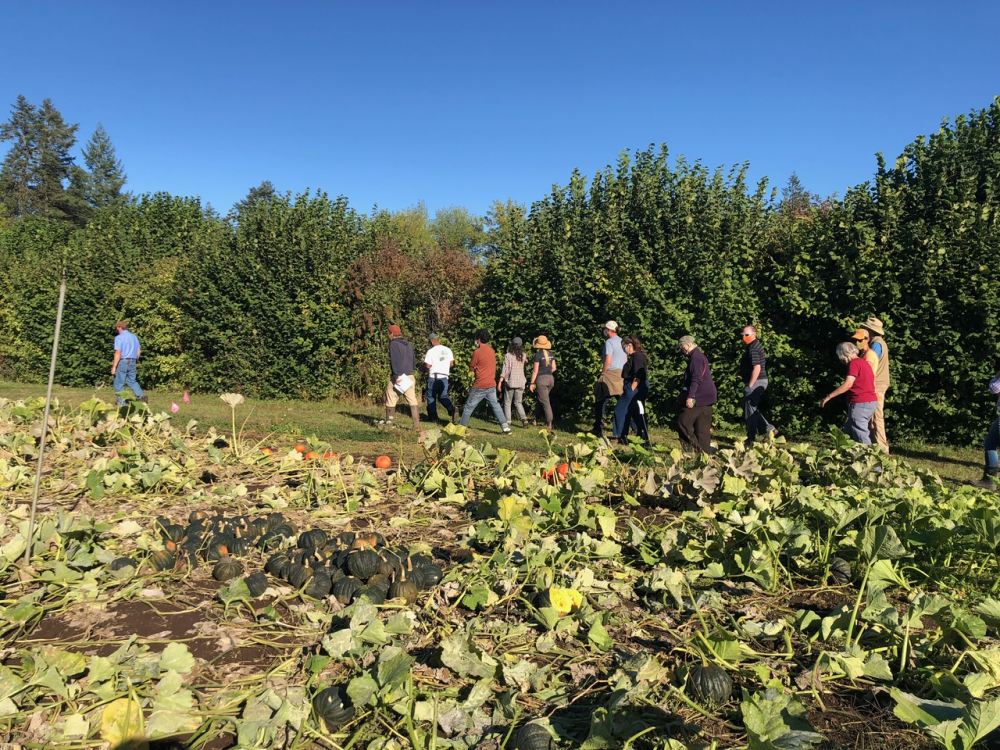
This year, the NOVIC team evaluated 12 Cucurbita maxima squash varieties, mostly of the kabocha type. Casey measured earliness, yield, fruit size and weight, tolerance of powdery mildew, and they will be tested for storage, sweetness and dry matter content. I wondered whether consumers prefer particular colors, and Casey noted that preferences can vary by culture; for example, in Asian markets there are more dark green varieties. One of the market farmers said that her customers prefer bright colors like orange and pink, and another said that her customers buy more squash when she displays a diverse selection--she encourages them to buy two varieties and compare them! And many customers, particularly those who aren’t cooking for a crowd, prefer smaller fruits. Lane Selman of the Culinary Breeding Network said that several of the varieties, which are not yet available in the US, came from Levantia, a seed company she visited in Italy, including the distinctive large, light blue turban-shaped Capello del Prete.
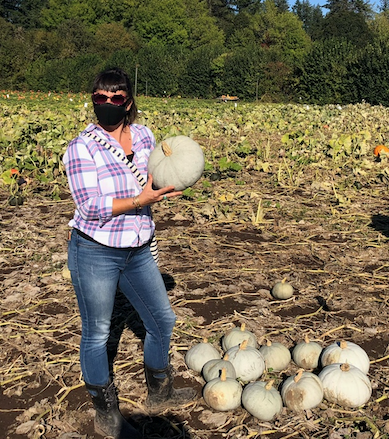 s
s
Lane Selman shows off blue ‘Vanity’ squash
When you spend many days in the field observing squash, as Casey does, you become aware of traits that might not be noticed at first glance. For example, some varieties, like the high-yielding and large open-pollinated ‘Stella Blue’, have an indentation around the stem. Ordinarily, this isn’t a problem, except when water leaks into the squash storage shed which happened last year--so moisture collected in the indentation! Some of the dark green varieties like the small ‘Blue Kuri’ were more susceptible than others to sunburn. Others, such as the small orange hybrid kabocha JWS 16-4252, and the dark green ‘Dulcinea F1’ exhibited more cucumber beetle damage on some fruits—resulting in a rough, scarred surface. Dark green ‘Sweet Mama’ had a lower yield than others in this year’s trial, but it would have produced more fruits if its semi-bush vines had been planted closer together than the vining varieties. Several farmers praised its sweet flavor. ‘Tetsukabuto’, a cross between Cucurbita maxima and Cucurbita moschata suffered the least damage from powdery mildew—although none of the varieties are completely resistant. Of all the varieties in the 2021 trial, ‘Vanity F1’ and ‘Stella Blue’ yielded highest. Results from this year’s trial will be compared to those from previous years and those from project collaborators in other regions.
Casey then brought the group to a table with a wonderful diversity of squash species that he grew from many different seed sources, including eBay! It included avocado Cucurbita moschata squash from South Korea, which is eaten as a round summer squash that resembles a large, green avocado, but it matures to a large, tan ribbed variety, and several large varieties of Cushaw (Cucurbita argyrosperma) squash. He held up the first ever yellow zucchini—the ‘Burpee’s Golden Zucchini ’, and the golden orange ‘Orangetti’ spaghetti squash bred by Harry Paris in Israel. He showed us Japanese Cucurbita moschata pumpkins, orange patty pans, and Zapallo del Tronco, a South American Cucurbita maxima popular in Argentina that is, like the Avocado squash, harvested green and enjoyed as a summer squash. While I don’t want to reveal too much about Casey’s experiments since he hasn’t yet published his Master’s thesis, we were all optimistic that they will result in even more nutritious squash varieties!
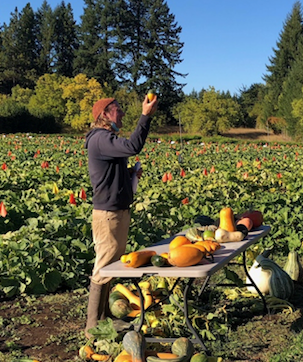
Casey Wilson with diverse squash species
Tromboncino squash (aka Zuchetta Rampicante) is a type of Cucurbita moschata similar to butternut that grows on long vines and the most widely available varieties have very long green fruits with a bulb at one end. They are usually eaten like zucchini, when green and not too large; if they are left on the vine, the skin gets thicker and they turn tan, like a butternut. Jim Myers showed us some new types of bicolor Tromboncino squash from his breeding program. Not only are they orange and green on the outside, but they are, amazingly, also bicolored on the inside! Beth, of Goodfoot Farm trialled them this year, and she preferred straighter fruits with more neck and less of a bulb at the end that contains the seeds, and she liked the bicolor varieties better than the solid colors. While, overall, she thought that Tromboncino squashes were less commercially viable for her farm than other types, they would make excellent crops for home gardeners—since they produce over a long season, can be used as summer squash or winter squash, and can be grown on a trellis.
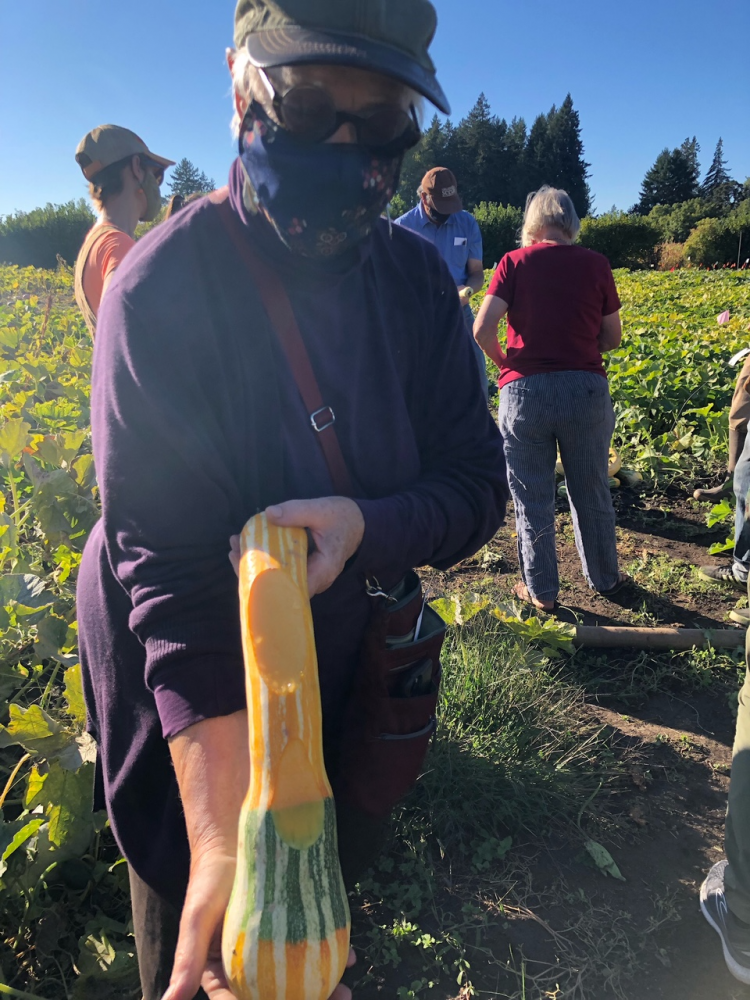
Bicolor Tromboncino!
We moved on to the beautiful display of Aji peppers—aka Capsicum baccatum, a pepper species with a citrusy, spicy flavor from South America. NOVIC is seeking varieties that will produce early in the northern U.S., and taste good at the wax stage as well as the fully colored ripe stage. Most Ajis in the trial were elongated but some were bonnet-shaped, and there was great variation in plant height and color: red, yellow, orange and light purple ripening to yellow. Varieties also differed in their heat and complexity of flavor. NOVIC is also trialing Shishito peppers, which are milder and are typically cooked quickly over high heat. As in the Aji trial, varieties are being tested for earliness and yield, as well as resistance to lodging and sunscald. This year, the earliest Shishito was ‘Mellowstar’.
Passing by a dry-farmed planting of ‘Oaxacan Green’ dent corn, and ‘Dakota Black’ popcorn, we moved along to the radicchio trial. Casey and several of the farmers agreed that it’s important to sow radicchio early enough—i.e. in early July in Oregon, so that it is heading by the first frost—since if it hasn’t produced a head by that time, it probably won’t. Many of the healthy and vigorous varieties in the trial, which are not yet quite ready to harvest, were from Smarties Bio, a small Italian seed company, and there was quite a bit of variation in terms of leaf color, the color and degree of ribbing, and the rounded, open or elongated heads. Lane Selman said that in Italy, plantings of different varieties are staggered on a strict schedule for harvest at specific times, so that there is a constant supply of radicchio all winter. Casey observed that, since there is so much variation in the days to maturity of different varieties, it is often quite difficult to compare them when they are all evaluated and tasted at the same time—and the same is true for squash!
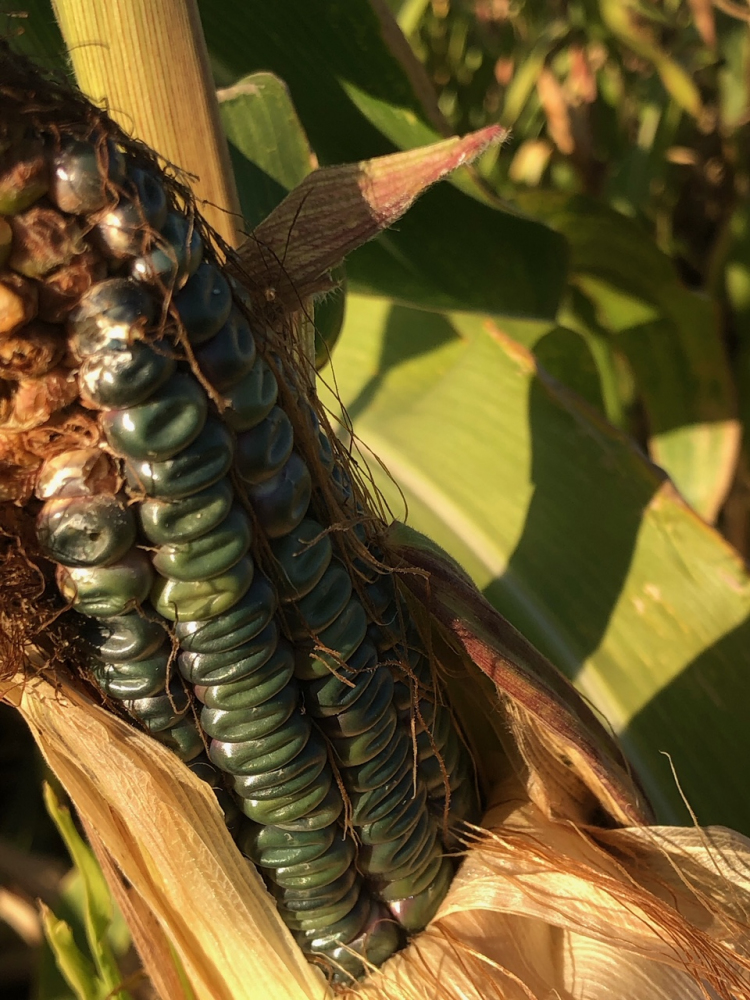
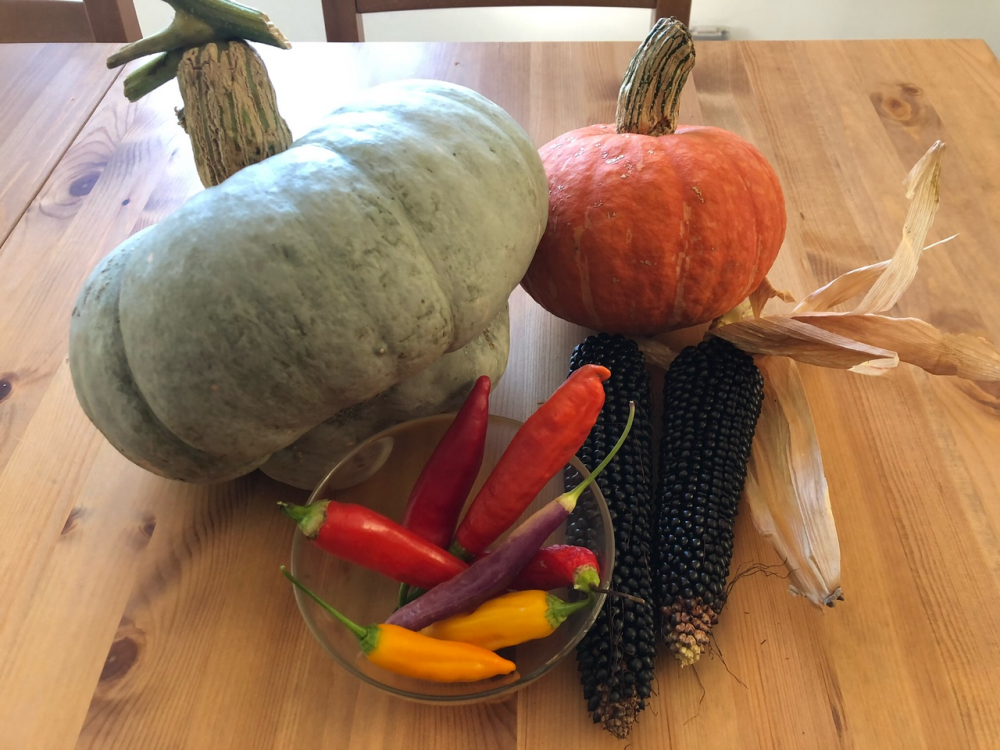
Oaxacan Green dent corn, ‘Capello del Prete’, orange kabocha trial variety and a selection of Aji peppers
Thanks to Casey Wilson, Taylor Kamsler, Jim Myers, Lane Selman, Joel Davis and all those who work so hard maintaining the trials at the OSU vegetable farm for this informative field day—and for letting us take home some veggies at the end of the day! For more information on the NOVIC project, see the project website at https://eorganic.info/novic/ . Trial results from past years are posted on the Organic Variety Trial Database, and this year’s results will be added there when the data is ready!
Funding

This project was funded by the Organic Research and Extension Initiative grant, part of the USDA National Institute of Food and Agriculture. Awards 2009-51300-05585 for NOVIC I (2009-2013), 2014-51300-22223 for NOVIC 2 (2014-2018) and 2018-51300-28430 for NOVIC 3 (2018-2022).

